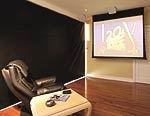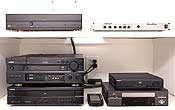Home Theater Hideaway Page 2
 While there would have been space in the main house for a serious home theater, Mom didn't want Dad's late-night music listening and movie watching to disturb her or their young daughter - a familiar scenario. And with another child on the way, it became even more important that he find a hideaway well isolated from the main living spaces. Now, thanks to Young and Tomblin's ingenuity, Dad has this retreat where he can indulge himself with Titanic or T2 and not bother anyone in the house.
While there would have been space in the main house for a serious home theater, Mom didn't want Dad's late-night music listening and movie watching to disturb her or their young daughter - a familiar scenario. And with another child on the way, it became even more important that he find a hideaway well isolated from the main living spaces. Now, thanks to Young and Tomblin's ingenuity, Dad has this retreat where he can indulge himself with Titanic or T2 and not bother anyone in the house.
The real beauty of this home theater, though, is its practicality and affordability. It takes up only 19 x 11 feet when in use (and none at all when it's not) and cost a little over $10,000 - or about as much as most people spend on a good front-projection system. This setup could easily fit into a typical basement, converted garage, or addition and still leave room for other activities - even if you left out the descending divider wall and decided to use it as a shared space.
 All of the electronics, which are in a closet behind the screen, are solid but affordable: a Yamaha 100-watt-per-channel receiver and five-disc DVD changer, a Zenith hi-fi VCR, and a Sony digital satellite receiver. There are three KEF speakers mounted on the ceiling in front, two Sonance in-ceiling surround speakers in back, and a 12-inch Sonance subwoofer placed just behind the closet door. (The bass from the sub's down-firing driver radiates into the room through the space between the floor and the bottom of the door.) The video system consists of a Stewart screen and a DreamVision Starlight projector that uses Digital Light Processing (DLP) technology. A DreamVision Dreamscaler was recently added to convert interlaced video to progressive scan and select the proper aspect ratios for different formats.
All of the electronics, which are in a closet behind the screen, are solid but affordable: a Yamaha 100-watt-per-channel receiver and five-disc DVD changer, a Zenith hi-fi VCR, and a Sony digital satellite receiver. There are three KEF speakers mounted on the ceiling in front, two Sonance in-ceiling surround speakers in back, and a 12-inch Sonance subwoofer placed just behind the closet door. (The bass from the sub's down-firing driver radiates into the room through the space between the floor and the bottom of the door.) The video system consists of a Stewart screen and a DreamVision Starlight projector that uses Digital Light Processing (DLP) technology. A DreamVision Dreamscaler was recently added to convert interlaced video to progressive scan and select the proper aspect ratios for different formats.
A Yamaha integrated touchscreen remote with extensive macro capability handles all control duties. Young programmed the remote so that the user only has to hit the System On and System Off controls. He also stripped out any of the virtual buttons that could have led to somebody accidentally hitting the wrong key and discombobulating the system. A Xantech infrared receiver on the wall accepts the remote's commands and passes them to the concealed system components, while the X-10 control beneath it interacts with the Yamaha receiver and the lights to dim the room when the System On macro is initiated. (X-10 technology, which was explained in "Beyond Audio/Video" in the October 2001 issue, allows A/V and other devices to "talk" to each other via existing 110-volt electrical wiring.)




























































